Can You Compost Clam Shells
Yes, you can compost clam shells, but you'll need to prepare them properly first. Start by cleaning the shells thoroughly, then sterilize them through boiling or baking to eliminate harmful bacteria. Crush the shells into smaller, gravel-sized pieces to speed up decomposition, which typically takes 6 months to 2 years. When adding to your compost, maintain a 10:1 carbon-to-nitrogen ratio and layer the crushed shells between nitrogen-rich materials. The shells will enrich your soil with essential nutrients like calcium and magnesium while improving drainage and moisture retention. Understanding the proper techniques and following local regulations will guarantee your composting success.
This post may contain affiliate links. If you make a purchase through these links, I may earn a commission at no additional cost to you. Additionally, portions of this post may be generated using artificial intelligence (AI) technology. While we strive for accuracy, please be aware that AI-generated content may not always be perfect and should be fact-checked when necessary.
The Spatula Scoops
- Yes, clam shells can be composted, but they must be crushed into small pieces first to speed up decomposition.
- Clam shells take 6 months to 2 years to break down completely in compost, depending on preparation and conditions.
- Shells must be cleaned and sterilized through boiling or baking before composting to eliminate bacteria and prevent pest attraction.
- Composted clam shells enrich soil with calcium, magnesium, and nitrogen while improving drainage and moisture retention.
- Maintain a 10:1 carbon-to-nitrogen ratio and layer crushed shells between nitrogen-rich materials for optimal composting results.
What Makes Clam Shells Compostable
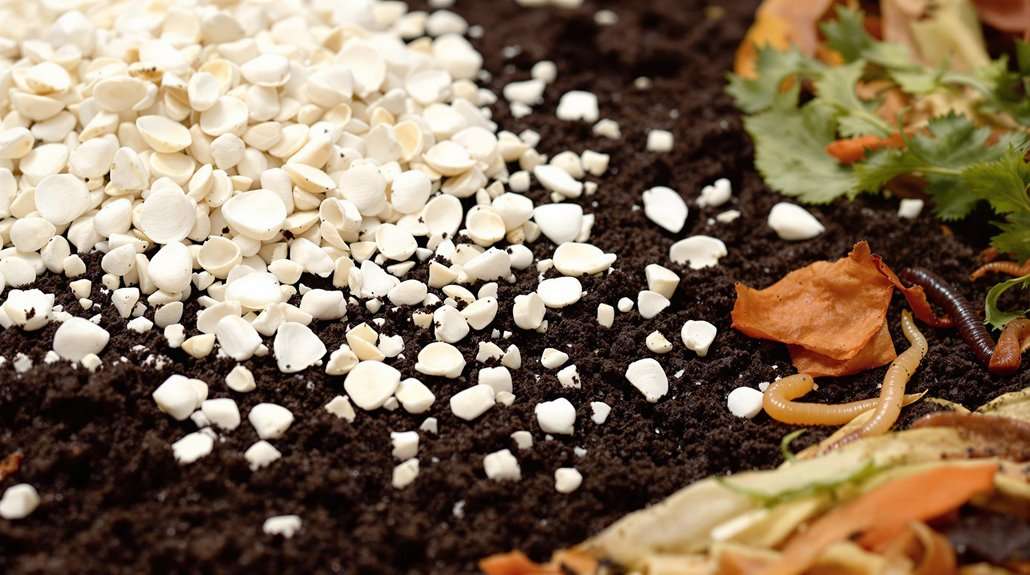
Today's compostable clam shells are revolutionizing food packaging with their eco-friendly composition. These innovative containers are crafted from renewable materials like wheat straw fiber, sugarcane bagasse, and plant-based PLA bioplastic, offering you a sustainable alternative to traditional packaging.
What makes these containers truly compostable is their natural composition and careful manufacturing process. You'll find they're made without harmful chemicals like PFAS, and they maintain their natural color without bleaching. These containers are available in sizes from 16oz to 80oz. When you're selecting these containers, you'll notice they come in different varieties: fiber-based ones for hot foods and clear PLA versions for cold items. They're engineered to meet strict ASTM standards for commercial composting while providing the durability and resistance to moisture you need.
The compostable properties stem from their plant-based construction, which allows them to break down naturally in commercial composting facilities. You can rely on these containers to handle everything from hot soups to cold salads while remaining freezer-safe and grease-resistant. They're specifically designed to decompose efficiently, making them a practical choice for businesses committed to reducing their environmental impact.
Benefits for Your Garden
Along with their eco-friendly properties, clam shells provide remarkable benefits for your garden's health and productivity. When you incorporate crushed clam shells into your soil, you'll add essential nutrients that release slowly over time, including calcium, magnesium, and nitrogen. These minerals are essential for preventing common garden problems like blossom end rot in your tomatoes and peppers. The natural composition ensures a healthy soil balance of approximately 45% minerals.
You'll notice improved soil structure as the shells break down, enhancing drainage while helping retain moisture. The chitin content in clam shells works to boost beneficial soil microorganisms, which naturally control harmful nematodes and contribute to overall soil health. If you're dealing with acidic soil, crushed shells will gradually help balance the pH levels.
For practical applications, you can use crushed clam shells as mulch around your plants, add them to your compost pile, or mix them directly into your garden soil. They're particularly effective for container gardens and houseplants, where you'll benefit from both their nutritional value and their ability to deter fungus gnats. By using clam shells in your garden, you're not only improving your soil but also participating in sustainable waste reduction.
Preparing Shells Before Composting
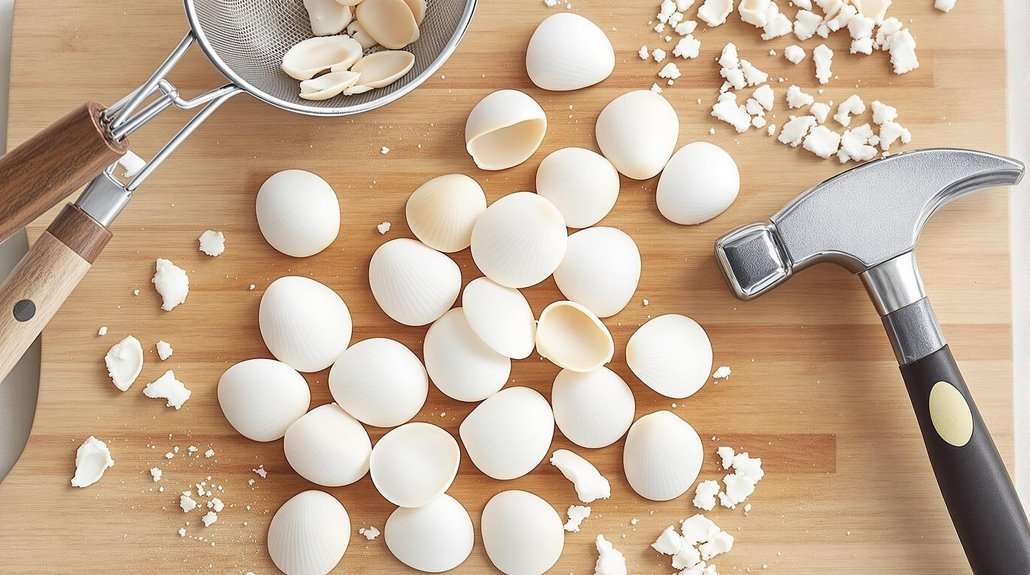
Proper preparation of clam shells is essential for successful composting. You'll need to start by thoroughly cleaning and sterilizing your shells through boiling, which eliminates harmful bacteria and potential pathogens like salmonella. Make certain you've removed all food debris and leftover particles, as these can attract unwanted pests to your compost pile. Dish towels protect the work surface and contain shell fragments during crushing.
Once your shells are clean and dry, you'll need to break them down into smaller pieces. You can use a mortar and pestle, hammer, or rolling pin for this task. The smaller you crush the shells, the faster they'll decompose in your compost – just like egg shells. Remember, larger pieces can take up to two years to break down completely.
When you're ready to add the crushed shells to your compost, maintain a ratio of about 1 part shells to 10 parts other composting materials. Layer your crushed shells between nitrogen-rich materials like grass clippings or fruit scraps, and cover them with a mixture of manure and soil. Don't forget to turn your pile regularly to guarantee proper aeration and even distribution of the shell pieces throughout the compost.
Best Composting Methods
Successful clam shell composting relies on a strategic layering approach combined with proper aeration techniques. You'll want to start with a 6-inch brown layer of dry leaves or twigs, followed by a 4-inch nitrogen layer of grass clippings or vegetable scraps. Place your crushed clam shells on top, then cover them with a 2-inch layer of manure and soil mixture. The calcium-rich minerals from decomposed shells will naturally enhance your soil's fertility.
To maintain ideal decomposition, you'll need to turn your compost every two days using a pitchfork. This guarantees proper air circulation and prevents anaerobic conditions from developing. You can also use a compost shredder to break down shells more efficiently, which will speed up the decomposition process.
Balance is essential when composting shells. Since clam shells have a high carbon-to-nitrogen ratio, you'll need to maintain a ratio of 1 part shells to 10 parts other composting materials. Include plenty of green materials like fresh grass clippings or coffee grounds to counterbalance the shells. If you're concerned about pests, bury shell pieces deeper in the pile and maintain proper moisture levels using a moisture meter.
Time to Break Down
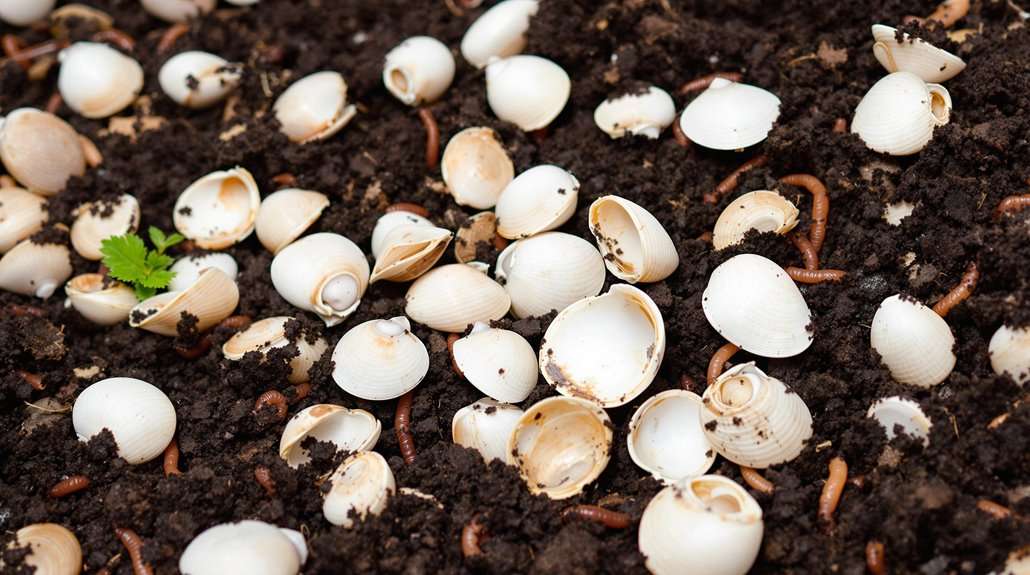
Breaking down clam shells in your compost takes considerable time, typically ranging from 6 months to 2 years depending on several key factors. You'll find that shell size plays an important role, as smaller pieces decompose much faster than larger ones. If you're looking to speed up the process, consider crushing or shredding your shells before adding them to your pile. Using a moisture meter will help ensure optimal decomposition conditions.
| Factor | Impact | Optimization |
|---|---|---|
| Shell Size | Larger shells take longer | Crush or shred shells |
| Composition | 10:1 carbon-nitrogen ratio | Add nitrogen-rich materials |
| Temperature | Affects breakdown speed | Maintain 135-150°F |
| Moisture | Essential for decomposition | Keep damp, not wet |
Your compost pile's composition will greatly influence breakdown time. You'll need to balance the carbon-rich shells with nitrogen-rich materials like grass clippings or manure. Environmental conditions also play an important role – maintain proper moisture levels and guarantee adequate oxygen circulation through regular turning. While you're waiting for the shells to break down, they'll continuously release calcium and other important nutrients that'll enrich your soil.
Common Challenges and Solutions
You'll find that clam shells naturally decompose at a slower rate than other compost materials, but you can speed up this process by crushing them into smaller pieces and maintaining proper moisture levels in your pile. Many cities require shells to be disposed of in dry undifferentiated waste rather than compost bins. To prevent any unwanted pest issues, it's crucial to thoroughly clean and sterilize the shells before adding them to your compost, ensuring they're free of any remaining organic matter that might attract animals. Your best approach is to bury the crushed shells deep within your compost pile, covering them with a thick layer of nitrogen-rich materials and turning the pile regularly to promote even decomposition.
Slow Decomposition Rate Solutions
The slow decomposition rate of clam shells presents several challenges for composters, but there are effective solutions to speed up the process. To address this issue, you'll need to focus on breaking down the shells into smaller pieces using tools like mortars, pestles, or hammers. The smaller the pieces, the faster they'll decompose and integrate with other materials. Consider cooking the shells at 250°F for 20 minutes to eliminate any harmful bacteria before composting.
You'll want to maintain proper balance in your compost pile by mixing your crushed shells with nitrogen-rich materials like grass clippings and fruit scraps. The ideal carbon-to-nitrogen ratio will help accelerate decomposition. Additionally, you should monitor moisture levels carefully – your compost should feel like a damp sponge but not saturated. Using a moisture meter can help you maintain excellent conditions.
Regular turning of your compost pile is essential for proper aeration and uniform decomposition. While you can expect the process to take anywhere from 6 months to 2 years, these steps will help guarantee steady progress. Remember that though the process is lengthy, the continuous release of calcium and nutrients makes it worthwhile for your soil's long-term health.
Pest Prevention Methods
Managing pest issues in clam shell composting requires a systematic approach to prevention and control. You'll need to start by properly sterilizing your shells through boiling, baking, or sun drying to eliminate potential pathogens and pests before adding them to your compost pile. If you're composting a small batch, you can even use your microwave for sterilization. Using eco-friendly containers for storing sterilized shells helps maintain cleanliness and prevents contamination.
Once you've sterilized your shells, you'll want to crush them into smaller pieces and integrate them properly into your pile. Make sure you're burying the crushed shells deep within your compost and covering them with a 2-inch layer of carbon-rich materials like manure and soil mix. This step is essential, as improperly managed shells can attract unwanted visitors to your compost.
To maintain a pest-free environment, you'll need to keep your compost pile well-balanced with proper ratios of green and brown materials. Regular turning promotes aeration and even decomposition, while maintaining adequate moisture levels prevents odors that might attract pests. If you notice any pest issues, consider using natural deterrents like diatomaceous earth or installing fencing around your compost area.
Environmental Impact of Shell Composting
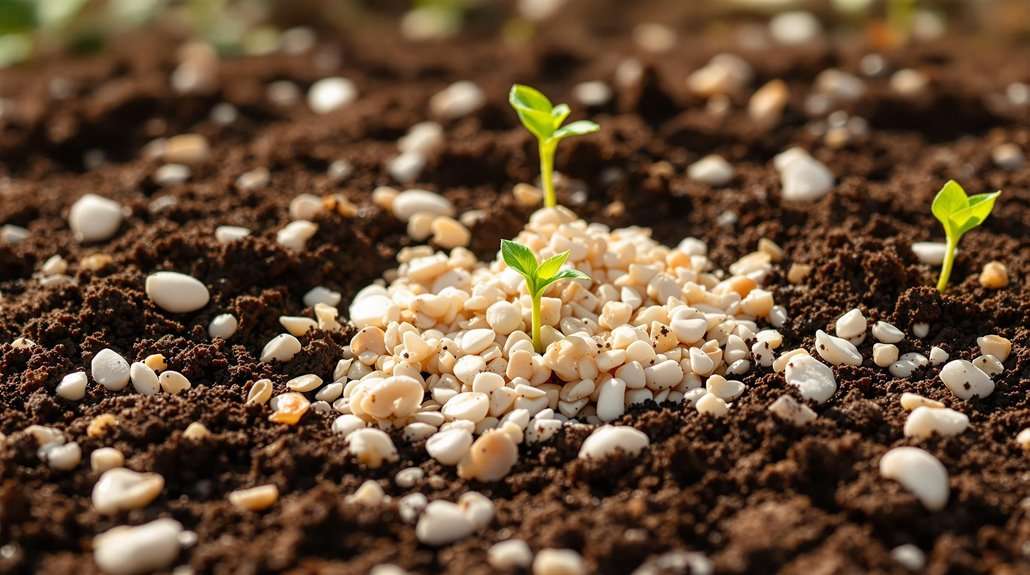
Through proper composting practices, clam shells can greatly benefit the environment while reducing waste in landfills. When you compost clam shells, you're contributing to a sustainable waste management system that keeps these materials out of overburdened disposal sites while creating valuable soil amendments.
The environmental impact of shell composting extends beyond waste reduction. As the shells break down over six months to two years, they release calcium carbonate that helps balance soil pH levels and provides essential nutrients for plant growth. You'll find that this natural process improves overall soil health, reduces the need for synthetic fertilizers, and supports long-term garden sustainability.
To maximize these environmental benefits, you'll need to properly prepare your shells. By crushing them into smaller pieces and ensuring proper sterilization, you're creating ideal conditions for decomposition while preventing potential pathogen issues. The calcium-rich shells integrate seamlessly into your compost pile, working alongside nitrogen-rich materials to create a balanced, nutrient-dense mixture that supports healthy plant growth while promoting sustainable gardening practices.
Local Regulations and Guidelines
Before composting your clam shells, you'll need to check your local waste management regulations, as rules for shell disposal vary considerably between cities and regions. Your local waste collection service might require specific preparation methods, such as crushing or sterilizing the shells, before they can be accepted into organic waste bins. Whether you're composting at home or using municipal services, understanding and following your area's guidelines will guarantee proper disposal and help you avoid potential fines or rejection of your waste materials.
City-Specific Rules Apply
Composting clam shells requires careful attention to your city's specific regulations and guidelines. Before you begin composting your shells, you'll need to check with your local waste management company to understand the rules that apply in your area, as disposal methods can vary considerably between cities.
While many cities require you to dispose of shells in regular waste bins due to their calcareous nature, some municipalities allow shell disposal in organic waste containers when properly prepared. You'll find that most cities don't permit shells in biodegradable waste collection, but there are exceptions if you follow specific disposal techniques. When composting is allowed, you'll need to verify you're meeting local requirements for shell preparation, which typically includes crushing and sterilizing the shells before adding them to your compost pile.
If your city permits shell composting, you can take advantage of their benefits, including pH balance improvement and calcium enrichment of your soil. Remember to maintain a proper ratio of one part crushed shells to ten parts other composting materials, and always verify your planned composting method aligns with local regulations.
Understanding Local Standards
Every community has distinct standards for composting clam shells, making it crucial to understand your local regulations thoroughly. You'll need to check with your waste management company to determine if they accept shells in organic waste bins and what specific preparation methods they require. Some facilities may have stricter guidelines than others, so don't assume what works in one city will work in another.
Before adding clam shells to your compost, you'll need to properly prepare them. Start by boiling the shells to eliminate pathogens, then crush them into smaller pieces to speed up decomposition. You should maintain a ratio of one part shells to ten parts other composting materials, mixing them with both nitrogen-rich and carbon-rich components. Keep in mind that raw shells aren't biodegradable without proper processing.
While shells can benefit your compost by providing calcium carbonate and helping balance pH levels, you must follow local composting facility standards. These typically align with ASTM guidelines and require regular monitoring of moisture levels and pile conditions. Contact your local waste management authority to ascertain you're meeting all necessary requirements for shell composting in your area.
Tips for Successful Shell Composting
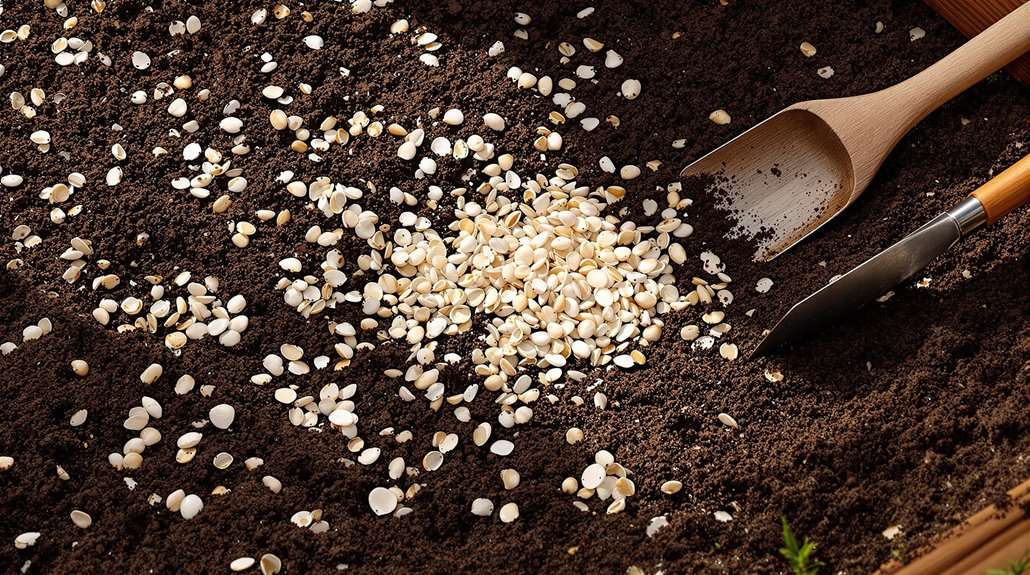
Successful shell composting requires careful preparation and proper layering techniques to achieve ideal decomposition. You'll want to start by crushing your clam shells into fine, gravel-sized pieces using a hammer, large rock, or mortar and pestle. If you're concerned about sanitization, you can boil the shells before crushing them.
When you're ready to add the shells to your compost pile, you'll need to follow a specific layering sequence. Start with carbon-rich materials like dry leaves and twigs, followed by nitrogen-rich materials such as grass clippings and vegetable scraps. Add your crushed shells on top of the nitrogen layer, then cover them with a two-inch layer of manure and soil mixture. This layering process helps maintain the ideal carbon-to-nitrogen ratio of 10:1 that clam shells provide.
To guarantee successful decomposition, you'll need to monitor moisture levels and turn your compost regularly. While it may take six months to two years for the shells to break down completely, they'll gradually release valuable calcium and help neutralize your compost's pH levels, creating nutrient-rich soil for your plants.
Frequently Asked Questions
Can Clam Shells Be Mixed With Worm Composting Bins?
You can add clam shells to your worm composting bin, but you'll need to prepare them properly. First, clean and sterilize the shells by boiling them, then crush them into small pieces. Mix them sparingly, using a 1:10 ratio of shells to other composting materials. They'll take 6 months to 2 years to decompose, but they'll provide valuable calcium and help balance your bin's pH levels.
Do Crushed Clam Shells Affect the Smell of Compost?
Like sentinels of freshness, crushed clam shells can actually help neutralize unpleasant odors in your compost. They're rich in calcium carbonate, which works to balance your pile's pH levels and create an environment where odor-causing bacteria can't thrive. You'll want to guarantee you're mixing the shells properly – about 1 part shells to 10 parts other materials – and maintaining regular aeration through turning for the best odor-controlling results.
Are Clam Shells Safe to Compost if Collected From the Beach?
It's not safe to compost beach-collected clam shells without proper preparation due to bacteria, parasites, and salt content. You'll need to thoroughly clean and sterilize them by boiling for at least 20 minutes to eliminate harmful microorganisms. After sterilizing, you should rinse the shells multiple times to remove residual salt, which can harm your compost pile's beneficial microbes and affect plant growth.
Should Shells From Cooked or Raw Clams Be Handled Differently?
You'll need to handle raw and cooked clam shells differently when composting. Raw shells require thorough sterilization to eliminate harmful bacteria and pathogens, while cooked shells have already gone through heat treatment. For both types, you'll want to crush the shells into smaller pieces, but you'll need to take extra precautions with raw shells, including wearing protective gloves and ensuring complete sterilization through boiling.
Can Clam Shell Compost Be Used for Acid-Loving Plants?
Just as oil and water don't mix, clam shell compost and acid-loving plants aren't compatible partners. You'll find that clam shells' high calcium carbonate content naturally raises soil pH, working against the acidic conditions these plants need to thrive. If you're growing azaleas, blueberries, or rhododendrons, you're better off avoiding clam shell compost or compensating with additional acidic amendments to maintain the lower pH they prefer.





